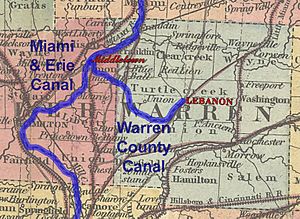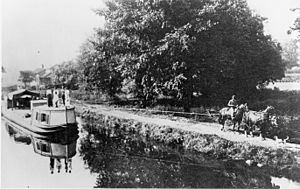Historic Ohio Canals facts for kids

Long ago, before cars and trains were common, canals were super important for moving things and people across Ohio. These man-made waterways helped connect towns and cities, making it easier to trade goods and for people to travel. Ohio had many historic canals that played a big part in its early growth.
Contents
Ohio's Historic Canals
In the early 1800s, Ohio was growing fast, but moving goods like farm products and timber was hard. Roads were often muddy and slow. Building canals was the perfect solution! These canals were like watery highways that allowed boats to carry heavy loads much faster and cheaper than by land. They connected Ohio's farms and factories to major rivers and lakes, helping the state's economy boom.
The Main Waterways
Ohio's two most famous canals were the Ohio and Erie Canal and the Miami and Erie Canal. They were like the main arteries of the state's transportation system.
The Ohio and Erie Canal
This canal was a huge project! It stretched from Cleveland on Lake Erie all the way down to Portsmouth on the Ohio River. Imagine a long, narrow river built by people, connecting the Great Lakes to the mighty Ohio River. This canal helped farmers send their crops to market and brought manufactured goods to growing towns. It was a very busy route for many years.
The Miami and Erie Canal
On the western side of Ohio, the Miami and Erie Canal connected Toledo on Lake Erie to Cincinnati on the Ohio River. Just like its eastern counterpart, this canal was vital for trade and travel. It helped move goods like grain, pork, and lumber, and allowed people to travel between cities. It was a major pathway for development in western Ohio.
Other Important Canals
Besides the two main canals, several other waterways helped connect different parts of Ohio. These smaller canals often branched off the main ones, serving specific towns or regions.
- Hocking Canal: This canal was a branch of the Ohio and Erie Canal. It helped connect the Hocking Valley region to the main canal system.
- Pennsylvania and Ohio Canal: This canal connected Ohio with Pennsylvania, allowing goods to move between the two states.
- Sandy and Beaver Canal: This canal aimed to connect the Ohio River with the Ohio and Erie Canal, helping transport coal and other resources.
- Wabash and Erie Canal: While much of this canal was in Indiana, a part of it extended into Ohio, connecting the Great Lakes to the Wabash River.
- Walhonding Canal: This was another branch of the Ohio and Erie Canal, serving the Walhonding Valley.
- Warren County Canal: As seen in the image, this was a branch of the Miami and Erie Canal, connecting the town of Lebanon to the larger canal network.
The End of the Canal Era
The canal era in Ohio lasted for several decades, but new technology eventually took over. The invention and spread of railroads in the mid-1800s changed everything. Trains were much faster than canal boats and could travel almost anywhere, even over hills. Slowly, the canals became less important, and many were abandoned or filled in.
Canals Today
Even though most canals are no longer used for transportation, their legacy lives on. Many old canal paths have been turned into hiking and biking trails, like the Ohio and Erie Canal Towpath Trail. These trails let us explore history and enjoy nature. Some sections of the canals still hold water and are used for recreation like fishing or kayaking. They remind us of a time when Ohio's waterways were its busiest roads.


